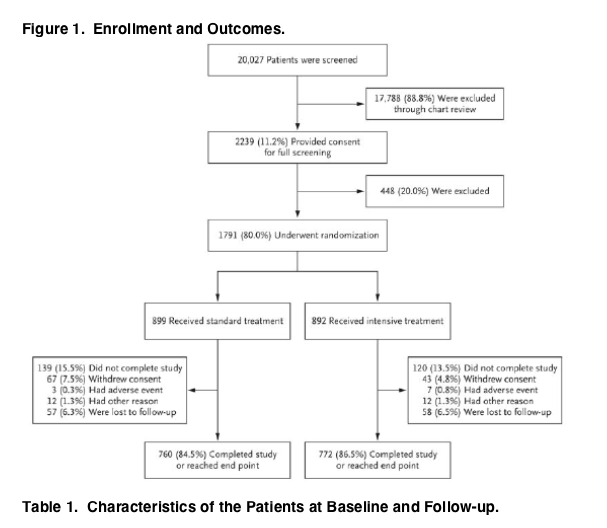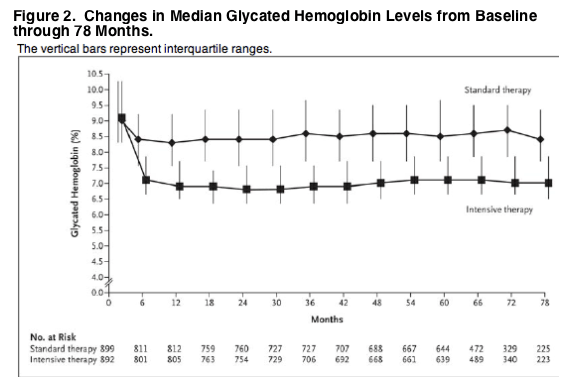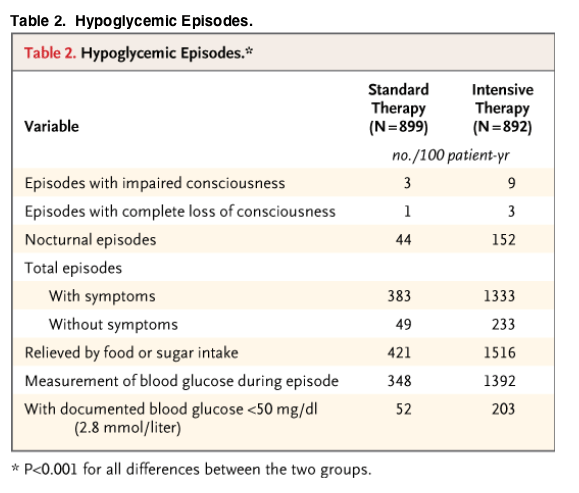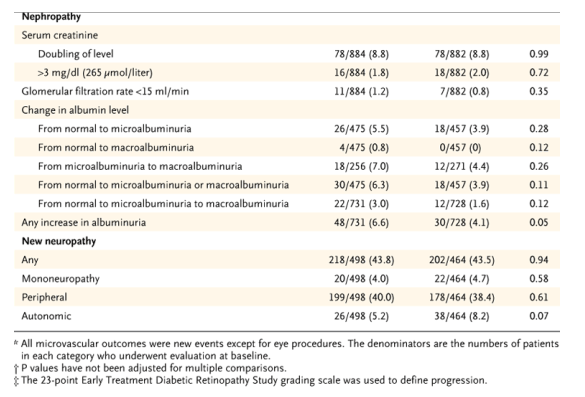| |
Glucose Control and Vascular Complications in Veterans with Type 2 Diabetes
|
| |
| |
NEJM Dec 17 2008
William Duckworth, M.D., Carlos Abraira, M.D., Thomas Moritz, M.S., Domenic Reda, Ph.D., Nicholas Emanuele, M.D., Peter D. Reaven, M.D., Franklin J. Zieve, M.D., Ph.D., Jennifer Marks, M.D., Stephen N. Davis, M.D., Rodney Hayward, M.D., Stuart R. Warren, J.D., Pharm.D., Steven Goldman, M.D., Madeline McCarren, Ph.D., M.P.H., Mary Ellen Vitek, William G. Henderson, Ph.D., Grant D. Huang, M.P.H., Ph.D., for the VADT Investigators
ABSTRACT
Background The effects of intensive glucose control on cardiovascular events in patients with long-standing type 2 diabetes mellitus remain uncertain.
Methods We randomly assigned 1791 military veterans (mean age, 60.4 years) who had a suboptimal response to therapy for type 2 diabetes to receive either intensive or standard glucose control. Other cardiovascular risk factors were treated uniformly. The mean number of years since the diagnosis of diabetes was 11.5, and 40% of the patients had already had a cardiovascular event. The goal in the intensive-therapy group was an absolute reduction of 1.5 percentage points in the glycated hemoglobin level, as compared with the standard-therapy group. The primary outcome was the time from randomization to the first occurrence of a major cardiovascular event, a composite of myocardial infarction, stroke, death from cardiovascular causes, congestive heart failure, surgery for vascular disease, inoperable coronary disease, and amputation for ischemic gangrene.
Results The median follow-up was 5.6 years. Median glycated hemoglobin levels were 8.4% in the standard-therapy group and 6.9% in the intensive-therapy group. The primary outcome occurred in 264 patients in the standard-therapy group and 235 patients in the intensive-therapy group (hazard ratio in the intensive-therapy group, 0.88; 95% confidence interval [CI], 0.74 to 1.05; P=0.14). There was no significant difference between the two groups in any component of the primary outcome or in the rate of death from any cause (hazard ratio, 1.07; 95% CI, 0.81 to 1.42; P=0.62). No differences between the two groups were observed for microvascular complications. The rates of adverse events, predominantly hypoglycemia, were 17.6% in the standard-therapy group and 24.1% in the intensive-therapy group.
The most common adverse event was hypoglycemia, with significantly more episodes in the intensive-therapy group than in the standard-therapy group in every category (P<0.001) (Table 2)
Conclusions Intensive glucose control in patients with poorly controlled type 2 diabetes had no significant effect on the rates of major cardiovascular events, death, or microvascular complications. (ClinicalTrials.gov number, NCT00032487 [ClinicalTrials.gov] .)
"Such factors as levels of HDL cholesterol, weight gain, systolic blood pressure, and pharmacologic agents could play a role in the observed lack of benefit of intensive glucose control and need to be examined in detail. Another possibility is a delayed benefit of intensive control, as seen at the 10-year follow-up in the DCCT-EDIC and UKPDS studies."...."Intensive glycemic control earlier in the disease course may produce benefit, especially if severe hypoglycemia is avoided. For now, appropriate management of hypertension, dyslipidemia, and other cardiovascular risk factors appears to be the most effective approach to preventing cardiovascular morbidity and mortality."
from Medpagetoday:
"Helena Rodbard, M.D., an endocrinologist in Rockville, Md., who was not involved with the study, said the established disease and high prevalence of other risk factors were significant limitations to the study.
Dr. Rodbard, past president of the American Association of Clinical Endocrinologists, cited earlier data indicating that cardiovascular events in diabetics are strongly correlated with the degree of vascular calcification.
Intensive glucose control begun and maintained in newly diagnosed patients is more likely to reduce cardiovascular and microvascular complications, she said.
"The upshot of it is, if we catch the patients early on, they are going to benefit from intensive treatment," she said. "If we wait too long, intensive treatment can be deleterious."
But Dr. Duckworth was not ready to give up entirely on intensive control for patients with established disease.
"We have to treat patients as patients," he said in an interview.
He said it would still be beneficial to push glycemic control as far as possible, as long as side effects -- especially hypoglycemia -- can be avoided, even in patients who have already begun to manifest complications.
Limitations noted by the authors included the fact that patients were predominantly men, limiting extrapolation to women, and the fact that changes in therapeutic agents have occurred since the design of the protocol, which might have different effects."
Several trials have shown that intensive glucose control in patients with type 2 diabetes mellitus reduces the progression of microvascular disease,1,2 but the effect on macrovascular complications remains uncertain. In epidemiologic studies, the association between glucose control and cardiovascular disease has not been consistent.3,4,5,6 Small short-term trials have suggested either benefit or adverse effects.7,8
Two recent studies, the Action in Diabetes and Vascular Disease: Preterax and Diamicron Modified Release Controlled Evaluation (ADVANCE) trial (ClinicalTrials.gov number, NCT00145925 [ClinicalTrials.gov] )9 and the Action to Control Cardiovascular Risk in Diabetes (ACCORD) trial (NCT00000620 [ClinicalTrials.gov] ),10 reported no significant decrease in cardiovascular events with intensive glucose control. The ACCORD trial ended its intensive therapy early, after 3.5 years, because of a significant increase in deaths in the intensive-therapy group. The primary goal of the Veterans Affairs Diabetes Trial (VADT) was to compare the effects of intensive and standard glucose control on cardiovascular events.
Discussion
The major cause of death and complications in patients with type 2 diabetes is cardiovascular disease. More than 60% of all patients with type 2 diabetes die of cardiovascular disease, and an even greater percentage have serious complications. The prevalence of vascular disease, hypertension, dyslipidemia, and other abnormalities is very high, and the consequences of these abnormalities are burdensome to patients, their families, and society.20
Interventions such as lifestyle changes, control of blood pressure and lipids, and antiplatelet therapy can reduce the development, progression, and complications associated with type 2 diabetes.21 Glucose control may reduce microvascular complications, but not cardiovascular complications. Even with microvascular complications, blood-pressure control has a greater effect than glucose control.22 In patients with advanced type 2 diabetes, the unanswered question is whether glucose control independently reduces cardiovascular complications.
Population surveys, cross-sectional studies, and short-term intervention trials have produced mixed results in attempts to answer this question.3,4,5,6,7,8 The United Kingdom Prospective Diabetes Study (UKPDS) showed a nonsignificant trend toward improvement in the rate of myocardial infarction (P=0.052) in patients with newly diagnosed disease, but the trial was complicated by less-than-strict blood-pressure and lipid control, according to current standards.1,22 Nevertheless, the trend was accepted by many observers as evidence of the importance of glucose control for macrovascular complications.
The Diabetes Control and Complications Trial (DCCT) did not show a significant reduction in cardiovascular events with intensive control in young patients with type 1 diabetes,2 but a follow-up study, the Epidemiology of Diabetes Interventions and Complications (EDIC) trial, showed a delayed benefit.23 Ten years after both groups reached similar glycated hemoglobin levels, the patients in the previous intensive-therapy group had significantly fewer cardiovascular events than those in the standard-therapy group.
Similar results were seen in the 10-year follow-up of the UKPDS.24 One year after the end of the trial, no significant difference in glycated hemoglobin levels was present. Despite this finding, in the original intensive-therapy group, there was a reduction in the risk of microvascular complications (15%, P=0.01), of any diabetes-related outcome (9%, P=0.04), of myocardial infarction (15%, P=0.01), and of death from any cause (13%, P=0.007). This delayed effect may have been associated with the cumulative effects of hyperglycemia.
Our study, along with the ADVANCE and ACCORD studies, examined different populations with different approaches and came to similar conclusions. Intensive glucose control did not reduce cardiovascular events in patients with previously diagnosed type 2 diabetes. The ACCORD study was terminated at 3.5 years because of increased mortality in the intensive-therapy group. The ADVANCE study showed a reduction in the progression of albuminuria, but there were no changes in the rates of severe nephropathy, retinopathy, or cardiovascular events.
The mean age of patients in the ACCORD study was 62 years, and the duration of diabetes was 10 years, with 35% of patients receiving insulin at baseline. The mean age in our study was 60 years, with 52% of patients receiving insulin and the remainder receiving a maximal dose of an oral agent; diabetes had been diagnosed a mean of 11.5 years earlier. The ADVANCE study had an older population (mean, 66 years) with a shorter disease duration of 8 years and 1.5% of patients receiving insulin at baseline.
In the three studies, baseline glycated hemoglobin levels were 7.2% in the ADVANCE study, 8.1% in the ACCORD study, and 9.4% in our study. After intensive therapy, glycated hemoglobin levels were 6.4% in the ACCORD and ADVANCE studies and 6.9% in our study; after standard therapy, the values were 7.5%, 7.0%, and 8.4%, respectively. None of these studies showed a decrease in cardiovascular events. The rates of hypoglycemia and weight gain were greater in the intensive-therapy group in all three trials.
In our study, we followed a population of veterans for up to 7.5 years (median, 5.6 years). Cardiovascular risk factors were controlled, and the between-group difference in glycated hemoglobin levels was maintained.25,26 Microvascular complications were minimally affected by intensive glucose control. No significant differences in retinopathy, major nephropathy, or neuropathy were seen. A nominally significant reduction (P=0.05) in any worsening of albumin excretion was observed in the intensive-therapy group. Overall, the benefit of decreasing the glycated hemoglobin level from 8.4% to 6.9% appeared to be minimal.
Our study had several limitations. Since we were studying veterans, the patients were predominantly men, and extrapolation of our findings to women must be done with caution. Changes in therapeutic agents have occurred since the design of our protocol. The protocol specified that any approved drug could be used, but the availability of new agents was limited. The study was designed to limit the effect of differences in agents used, but it remains possible that newer agents might have different effects. Since studies with intensive control of risk factors were not available at the time of the protocol development, the study may have been underpowered. This concern is lessened by the very similar results in the ACCORD and ADVANCE studies.9,10
Such factors as levels of HDL cholesterol, weight gain, systolic blood pressure, and pharmacologic agents could play a role in the observed lack of benefit of intensive glucose control and need to be examined in detail. Another possibility is a delayed benefit of intensive control, as seen at the 10-year follow-up in the DCCT-EDIC and UKPDS studies.
Nevertheless, the results of this and other studies do not indicate that intensive glucose control in this population decreased the rate of cardiovascular events. In addition, it appears that intensive glucose control had minimal effects on microvascular complications during a period of 5 to 6 years. Intensive glycemic control earlier in the disease course may produce benefit, especially if severe hypoglycemia is avoided. For now, appropriate management of hypertension, dyslipidemia, and other cardiovascular risk factors appears to be the most effective approach to preventing cardiovascular morbidity and mortality.
Results
Patients
From December 1, 2000, to May 30, 2003, a total of 1791 patients were enrolled in the study, with follow-up ending on May 30, 2008 (Figure 1). The main reasons for exclusion were that patients had low glycated hemoglobin levels (34% of patients), were not receiving a maximal dose of an oral antidiabetic medication or insulin (16%), did not want to participate (12%), or had a high serum creatinine level (8%). Baseline and follow-up data are shown in Table 1. No significant differences in risk factors at baseline or at follow-up were seen between the two groups, except for weight changes at follow-up. The mean age of patients was 60.4 years, and diabetes had been diagnosed a mean of 11.5 years earlier. The mean BMI was 31.3. The mean glycated hemoglobin level at baseline was 9.4%. Hypertension (which was defined as current treatment for hypertension or a blood pressure of 140/90 mm Hg or more) was present in 72% of patients, and 40% had already had a cardiovascular event. A history of microvascular complications was reported in 62% of the patients. At baseline, 52% of the patients were receiving insulin.


The mean baseline blood pressure was 132/76 mm Hg in the two groups. After 6 years, for patients who were still in follow-up, the mean blood pressure was 125/69 mm Hg in the standard-therapy group and 127/68 mm Hg in the intensive-therapy group. In both groups, mean lipid levels improved during the study, and levels of low-density lipoprotein cholesterol decreased to 80 mg per deciliter (2.1 mmol per liter). Levels of high-density lipoprotein (HDL) cholesterol increased to 41 mg per deciliter (1.1 mmol per liter) in the standard-therapy group and to 40 mg per deciliter (1.0 mmol per liter) in the intensive-therapy group. Levels of triglycerides decreased to 159 mg per deciliter (1.79 mmol per liter) in the standard-therapy group and to 151 mg per deciliter (1.70 mmol per liter) in the intensive-therapy group. The use of antiplatelet drugs increased to 91% and 94% of patients in the two groups, respectively, and statin use increased to 83% and 86% of patients, respectively.16 Weight and BMI were significantly greater (by 9 lb [4 kg] and 1.5, respectively; P=0.01) in the intensive-therapy group after treatment.
At 3 months, median glycated hemoglobin levels had decreased in both groups and had stabilized at 6 months, with a level of 8.4% in the standard-therapy group and 6.9% in the intensive-therapy group. This result achieved the prespecified goal of an absolute between-group difference of 1.5 percentage points (Figure 2). No significant benefit in the time to the first occurrence of a cardiovascular event was observed in the intensive-therapy group (hazard ratio, 0.88; 95% confidence interval [CI], 0.74 to 1.05; P=0.14) (Figure 3A). Both groups had fewer events than predicted. The predicted event rate was 40.0% in the standard-therapy group and 31.6% in the intensive-therapy group, a relative reduction of 21.0%. The observed event rate was 33.5% in the standard-therapy group and 29.5% in the intensive-therapy group, a relative reduction of 11.9%. There was no evidence that the effect of treatment varied according to either insulin status at baseline or the previous occurrence of a cardiovascular event (P=0.37 and P=0.92, respectively).

There were no significant differences in individual components of the primary and secondary outcomes (Appendix 1 and Appendix 2, respectively, in the Supplementary Appendix, available with the full text of this article at NEJM.org). There was no significant difference in the time to death from cardiovascular causes (P=0.26) (Figure 3B). No significant differences in the rate of deaths from cardiovascular causes were seen in the two groups. (The causes of 33 deaths from cardiovascular causes in the standard-therapy group and 40 deaths in the intensive-therapy group are listed in Appendix 3 in the Supplementary Appendix.) In the intensive-therapy group, the number of sudden deaths (11 deaths) was nearly three times the number in the standard-therapy group (4 deaths, P=0.08).
There were 95 deaths from any cause in the standard-therapy group and 102 in the intensive-therapy group (hazard ratio, 1.07; 95% CI, 0.81 to 1.42; P=0.62) (Figure 3C). Major causes of death from noncardiovascular causes are listed in Appendix 4 in the Supplementary Appendix. No significant differences were seen in any category. The most common adverse event was hypoglycemia, with significantly more episodes in the intensive-therapy group than in the standard-therapy group in every category (P<0.001) (Table 2). Other events meeting the criteria of severe adverse events are listed in Appendix 4 in the Supplementary Appendix. More patients in the intensive-therapy group had at least one serious adverse event (24.1%) than in the standard-therapy group (17.6%, P=0.05). Dyspnea was the most common specified serious adverse event and was more frequent in the intensive-therapy group (P=0.006).

Microvascular Results
There were no significant differences between the two study groups in the number of new eye procedures (Table 3). The cumulative rates of events in all patients, including those who had undergone eye procedures at baseline, did not differ significantly. Fundus photographs showed no significant differences in progression to proliferative diabetic retinopathy (P=0.27) or in progression to clinically important macular edema (P=0.31). There was a nonsignificant trend toward a beneficial effect in the intensive-therapy group with respect to diabetic retinopathy, with an increased incidence of at least two steps in severity in the standard-therapy group (P=0.07). The between-group difference in new onset of retinopathy was not significant (P=0.27).


The GFR declined to 76 ml per minute by year 6 (P<0.001) with no difference between the two study groups (P=0.36). Severe renal changes were unaffected by treatment (P=0.35). Any worsening of albumin excretion was greater in the standard-therapy group (P=0.05).
There was a nonsignificant increase in autonomic neuropathy in the intensive-therapy group (P=0.07). No other significant changes in neuropathy were seen.
Methods
Study Design
The design of our open-label study targeting patients with poorly controlled type 2 diabetes has been reported previously.11 Selection criteria included an inadequate response to maximal doses of an oral agent or insulin therapy. Exclusion criteria included a glycated hemoglobin level of less than 7.5%, the occurrence of a cardiovascular event during the previous 6 months, advanced congestive heart failure, severe angina, a life expectancy of less than 7 years, a body-mass index (BMI, the weight in kilograms divided by the square of the height in meters) of more than 40, a serum creatinine level of more than 1.6 mg per deciliter (141 μmol per liter), and an alanine aminotransferase level of more than three times the upper limit of the normal range.11
The study was sponsored by the Veterans Affairs Cooperative Studies Program. Medications and financial support were provided by Sanofi-Aventis, GlaxoSmithKline, Novo Nordisk, Roche, Kos Pharmaceuticals, and Amylin. These companies had no role in the design of the study, in the accrual or analysis of the data, or in the preparation of the manuscript. All authors vouch for the accuracy and completeness of the data and the analysis.
Protocol and consent forms were approved by the institutional review board at each of the 20 participating sites. All patients provided written informed consent. An independent data and safety monitoring committee whose members were aware of study-group assignments monitored safety and efficacy.
Treatment Protocol
Patients were randomly assigned with the use of a permuted-block design with a block size of six and stratified according to study site, the previous occurrence of a macrovascular event, and current insulin use. The randomization codes were generated by the study's biostatistician at the Hines Cooperative Studies Program Coordinating Center. Study sites did not have access to the codes. In both study groups, patients with a BMI of 27 or more were started on two oral agents, metformin plus rosiglitazone; those with a BMI of less than 27 were started on glimepiride plus rosiglitazone. Patients in the intensive-therapy group were started on maximal doses, and those in the standard-therapy group were started on half the maximal doses. Before any change in oral medications, insulin was added for patients in the intensive-therapy group who did not achieve a glycated hemoglobin level of less than 6% and for those in the standard-therapy group with a level of less than 9%. Subsequent changes in medication were determined according to protocol guidelines and local assessment. The guidelines allowed for the use of any approved drug at the discretion of the investigator. The goal for glycated hemoglobin levels was an absolute reduction of 1.5 percentage points in the intensive-therapy group, as compared with the standard-therapy group.
Other modifiable cardiovascular risk factors were treated identically in the two study groups. Treatment guidelines (based on recommendations of the American Diabetes Association, which were updated as necessary) for blood pressure and lipid control, as well as for dietary, exercise, and diabetes education, were provided to all patients.12 All patients were prescribed aspirin and a hydroxymethylglutaryl coenzyme A reductase inhibitor (statin) unless contraindicated.
Primary and Secondary Outcomes
The primary outcome was the time to the first occurrence of any one of a composite of cardiovascular events, adjudicated by an end-point committee that was unaware of assignments to study groups. The cardiovascular events were documented myocardial infarction; stroke; death from cardiovascular causes; new or worsening congestive heart failure; surgical intervention for cardiac, cerebrovascular, or peripheral vascular disease; inoperable coronary artery disease; and amputation for ischemic gangrene.
Secondary cardiovascular outcomes included new or worsening angina, new transient ischemic attacks, new intermittent claudication, new critical limb ischemia, and death from any cause. Secondary outcomes also included microvascular complications (retinopathy, nephropathy, and neuropathy). Adverse events, including hypoglycemia, were monitored.
Microvascular and Neuropathy Outcomes
Patients underwent a standard annual ophthalmologic examination. Stereo seven-field fundus photographs were obtained at baseline and at 5 years by certified photographers in 17 participating hospitals.13,14 The 23-point Early Treatment Diabetic Retinopathy Study grading scale was used to define progression to new proliferative diabetic retinopathy.15 The progression of retinopathy was defined as a 2-point increase on the scale. New, clinically important macular edema was defined according to standards reported previously.16 The glomerular filtration rate (GFR) was estimated on the basis of serum creatinine levels.17 Severe nephropathy was defined as a doubling of the serum creatinine level, a creatinine level of more than 3 mg per deciliter (265 μmol per liter), or a GFR of less than 15 ml per minute. The progression of albuminuria was defined as an increase of albuminuria for at least two successive yearly visits without reversion to an improved level. New neuropathy was assessed in a complete annual physical examination. Mononeuropathies were defined as mononeuropathy, mononeuropathy multiplex, or femoral neuropathy. Peripheral neuropathies were defined as radiculoneuropathy, polyneuropathy, diabetic amyotrophy, or neuropathic ulcer. Autonomic neuropathies were defined as symptomatic orthostatic hypotension, gastroparesis, neurogenic bladder, or diabetic diarrhea. The type of neuropathy was defined as the first outcome that was reached.
Statistical Analysis
The planned sample size of 1700 patients provided a power of 86% to detect a relative difference of 21% in the rate of the composite cardiovascular outcome (40.0% in the standard-therapy group vs. 31.6% in the intensive-therapy group), assuming no difference until the third year, 2 years of data accrual, 5 years of follow-up, a dropout rate of 5%, and a two-sided alpha of 0.05, adjusted for seven interim analyses with the use of O'Brien-Fleming boundaries.18,19 The expected number of events was 684. The 6-year event rate of 40% in the standard-therapy group was derived from the results of the Veterans Affairs Diabetes Feasibility Trial.8
Prespecified subgroups included patients who had received insulin therapy at baseline and those who had already had a cardiovascular event. Subgroups that were not prespecified (e.g., according to age, ethnic background, and duration of disease) are not reported here. All analyses were based on the intention-to-treat principle. Survival analysis compared the time from randomization to the occurrence of the first primary outcome. Data from patients without an event were censored at the date of withdrawal from the study or the final follow-up visit. Deaths occurring after withdrawal from the study were included in the analysis.
Kaplan-Meier survival curves were generated by the product-limit method. Intergroup differences were evaluated with the use of the log-rank test. The Cox proportional-hazards model was used to calculate estimates of relative risk and 95% confidence intervals for the two study groups. The heterogeneity of treatment effects in prespecified subgroups was assessed by including interaction terms in Cox models. The chi-square test was used to analyze differences in proportions unless events were rare, such as progression of nephropathy and retinopathy, in which case Fisher's exact test was used. Data are expressed as means and standard deviations or as medians with interquartile ranges when specified. All reported P values are two-sided and have not been adjusted for multiple comparisons. Because of the interim analyses, the critical value for statistical significance of the primary outcome was 0.0357.
|
|
| |
| |
|
|
|